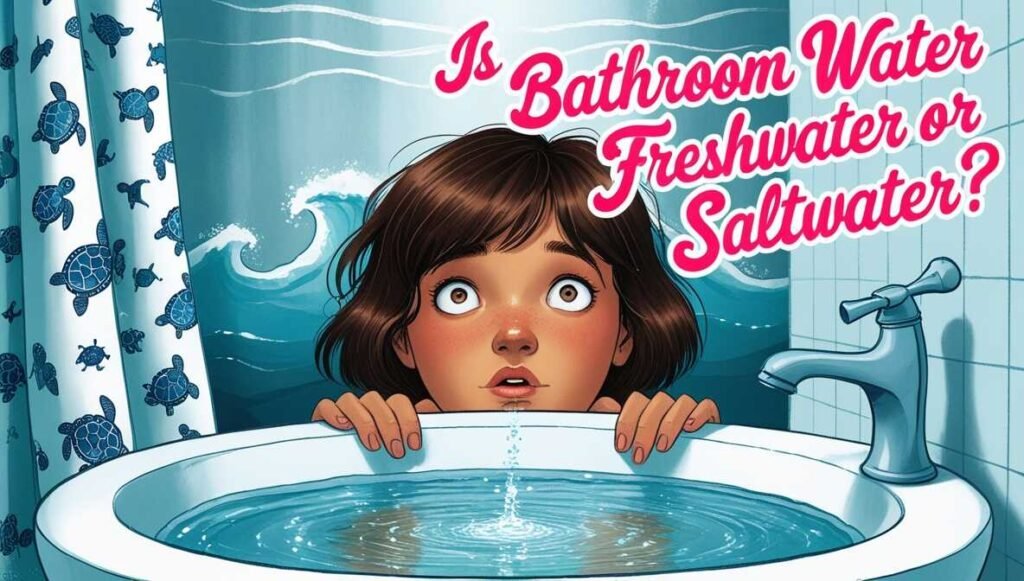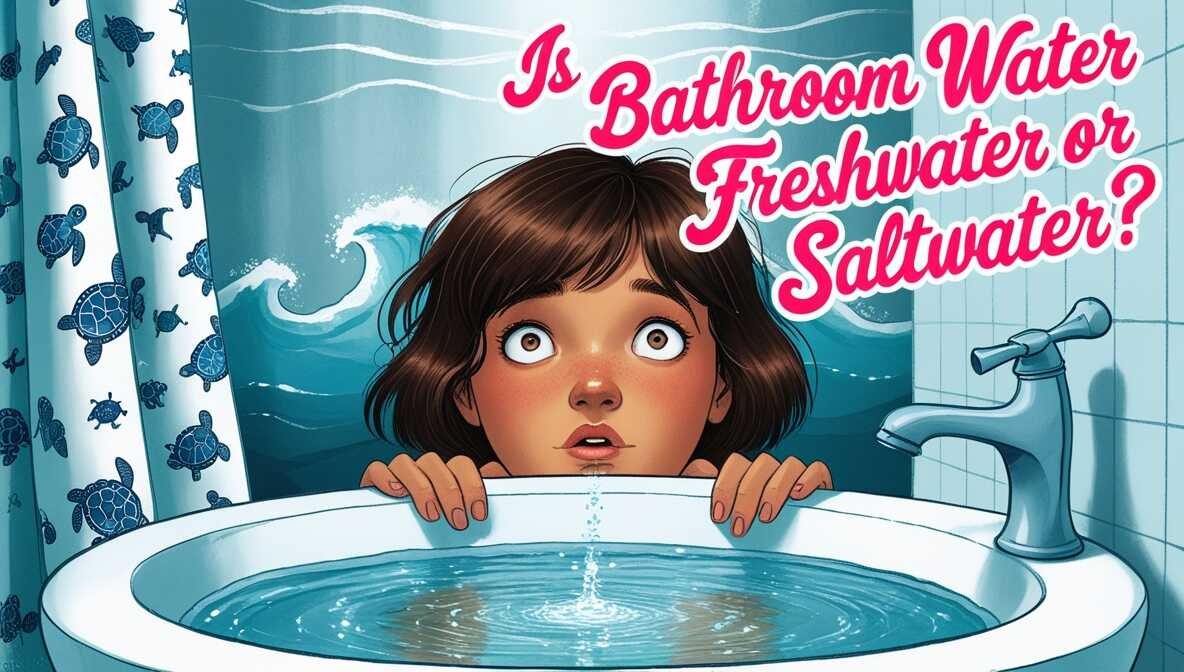Have you ever wondered if the water from your bathroom tap is freshwater or saltwater? While it may not always taste the same as the water from your kitchen faucet, bathroom water is still classified as freshwater. But what exactly makes it freshwater, and how does it differ from saltwater?
In this article, we’ll answer the question: “Is Bathroom Water Freshwater or Saltwater?” by exploring its source, treatment process, and characteristics. Understanding the difference between freshwater and saltwater is essential, as it affects drinking water quality, household use, and plumbing safety. Whether you’re brushing your teeth or filling a bathtub, knowing what type of water flows through your home can help you make informed choices about water consumption and filtration.

Understanding Bathroom Water Sources
The water that flows from your bathroom tap primarily comes from freshwater sources, but the specific origin depends on your location and water supply system. Here’s a breakdown of the main sources of bathroom water:
1. Public Water Supply
Most homes receive freshwater from municipal water treatment plants, which source water from rivers, lakes, and reservoirs. This water undergoes rigorous filtration and purification to ensure it meets safety standards before reaching your home.
2. Well Water Supply
Homes with private wells draw water from underground aquifers. This groundwater is naturally freshwater and may require filtration to remove minerals or contaminants. Since well water isn’t connected to a municipal supply, homeowners are responsible for regular testing and treatment.
3. Desalinated Water Supply
In some coastal regions with limited access to freshwater, households may receive desalinated seawater. Desalination removes salt and impurities from seawater, making it safe for use in bathrooms, kitchens, and drinking water systems.
While all these sources provide freshwater, the treatment process ensures it meets clean water standards, making it safe for bathing, washing, and in most cases, drinking.
Difference between Freshwater and Saltwater
To determine whether bathroom water is freshwater or saltwater, it’s important to understand the key differences between these two types of water.
Freshwater Definition
Freshwater is water that contains a low concentration of dissolved salts, typically less than 1,000 parts per million (ppm) or 0.1%. This makes it suitable for drinking, bathing, and household use without the need for extensive desalination.
Common sources of freshwater include:
- Rivers and lakes – Natural surface water sources used for municipal supplies.
- Groundwater – Water stored in underground aquifers, often accessed through wells.
- Rainwater – Naturally pure water that can be collected for various uses.
Saltwater Definition
Saltwater contains a high concentration of dissolved salts, typically around 35,000 ppm or 3.5% salinity. Because of its high salt content, saltwater is not suitable for drinking or most household uses unless it undergoes desalination.
Common sources of saltwater include:
- Oceans and seas – The Earth’s primary saltwater reservoirs.
- Saltwater lakes – Some lakes, like the Dead Sea, have high salt concentrations.
Since household plumbing systems are connected to freshwater sources, the water in your bathroom tap is classified as freshwater, ensuring it is safe for daily activities.

Is Bathroom Water Freshwater or Saltwater?
Mostly Freshwater
In the vast majority of locations, bathroom water is classified as freshwater. It typically comes from municipal water supplies, wells, or desalinated sources, all of which undergo filtration and purification before reaching homes. This ensures that the water is safe for bathing, washing, and in some cases, even drinking.
Potential Salinity Issues
While bathroom water is not saltwater, some areas experience hard water, which contains higher levels of dissolved minerals like calcium and magnesium. This can sometimes give the water a slightly saline taste or leave mineral buildup on fixtures, but it does not classify the water as saltwater.
Exceptions: Desalinated Water
In certain coastal cities and island regions where natural freshwater sources are limited, desalinated seawater is used. However, this water undergoes a rigorous desalination process to remove excess salt, ensuring it meets freshwater standards before being supplied to homes.
So, while your bathroom water is almost always freshwater, factors like hard water minerals or desalinated sources may slightly alter its composition.
Is Your Bathroom Tap Water Safe to Drink?
Many people wonder whether bathroom tap water is safe for drinking, especially when it comes from the same municipal supply as kitchen water. While it is technically freshwater, there are a few factors that may affect its quality.
Quality Differences
- Drinking Water (Kitchen Tap): The water from your kitchen tap is often filtered or treated specifically for drinking, ensuring it meets the highest safety standards.
- Bathroom Tap Water: While it comes from the same freshwater source, it may pick up impurities from older pipes, storage tanks, or plumbing fixtures, making it less ideal for drinking.
Risk Factors
- Old or corroded pipes – If your home has outdated plumbing, metals like lead or copper may leach into the water.
- Water stagnation – In some homes, bathroom water may sit in storage tanks or pipes for longer periods, increasing the risk of bacterial growth.
Best Practices
- If you’re unsure about your bathroom water quality, it’s best to use kitchen tap water for drinking.
- Consider installing a water filter on your bathroom tap if you want to ensure clean, safe drinking water.
- Run the tap for a few seconds before drinking to flush out any stagnant water from the pipes.
While bathroom tap water is usually safe, taking precautions can help ensure you’re consuming the best quality water for your health.
Differences Between Bathroom Water and Kitchen Water
| Feature | Bathroom Water | Kitchen Water |
| Source | Freshwater from municipal or well supply | Same source as bathroom water |
| Treatment | May pass through old pipes, affecting quality | Often passes through additional filters |
| Safe for Drinking? | Generally safe, but less ideal | Preferred for drinking and cooking |
| Potential Risks | Pipe impurities, stagnant water in storage | Usually cleaner due to direct flow from the main supply |
Does Saltwater Ever Come Through Bathroom Taps?
While bathroom tap water is typically freshwater, there are rare cases where saltwater intrusion or high mineral content can impact its taste and quality.
1. Rare Cases in Coastal Regions
- Some homes near the ocean may experience saltwater intrusion in homes, where seawater seeps into underground freshwater supplies due to over-pumping of groundwater.
- This can lead to slightly salty or brackish water coming through bathroom taps, especially in areas with weak water management systems.
2. Hard Water and Mineral Content
- Some regions have hard water, which contains high levels of calcium, magnesium, and other dissolved minerals.
- While this may cause a slightly salty taste, it does not classify the water as saltwater.
- Freshwater vs saltwater plumbing systems differ in design, ensuring that saltwater is not supplied for household use.
3. Desalinated Water Usage
- In some coastal and desert regions, municipalities rely on desalination plants to convert seawater into freshwater for household use.
- The municipal water supply undergoes extensive filtration and purification to remove excess salt, ensuring safe water for bathrooms and kitchens.
How to Ensure Bathroom Water is Safe?
If you’re concerned about your bathroom tap water quality, here are steps to check and improve its safety:
1. Test Your Water
- Use a home water test kit to check for contaminants, salt levels, and heavy metals.
- If you live near the coast, test for saltwater intrusion in your plumbing.
2. Filter Your Water
- Install water filters on bathroom taps or use a whole-house filtration system to remove impurities, excess minerals, and unwanted tastes.
3. Flush the Taps
- Before using bathroom tap water for drinking or brushing, let it run for a few seconds to flush out any stagnant water from the pipes.
By understanding how your municipal water supply works and taking preventive measures, you can ensure that your bathroom water remains clean, safe, and free from salt contamination.
Expert Quotes on Freshwater vs. Saltwater in Residential Plumbing
When it comes to understanding freshwater vs. saltwater plumbing, experts emphasize that residential water systems rely on freshwater to ensure safety and longevity.
1. USGS (United States Geological Survey)
“Residential water systems rely on freshwater to meet health standards.”
— USGS, highlighting that municipal water supply systems are designed to provide safe, treated freshwater for household use.
2. Plumbing Professionals
“Saltwater would corrode pipes within months.”
— Plumbing experts, explaining why saltwater intrusion in homes is a major concern. Saltwater can accelerate pipe corrosion, reduce plumbing lifespan, and damage household appliances.
These insights reinforce why bathroom tap water is almost always freshwater and why any saltwater contamination needs to be addressed immediately.
Conclusion: Is Bathroom Water Freshwater or Saltwater?
The final answer is that bathroom water is freshwater, as it comes from the same municipal or well supply as kitchen tap water. However, its quality may differ due to plumbing conditions, pipe materials, and possible water stagnation.
If you’re unsure about your bathroom tap water quality, it’s best to use filtered or kitchen tap water for drinking to ensure safety. Regular testing and filtration can help maintain clean and safe water for all household uses.
For peace of mind, consider conducting a home water quality test to check for contaminants, minerals, and potential plumbing issues. Understanding your water source and treatment process ensures that you’re using the best quality water for your home.
Now you know the answer to “Is bathroom water freshwater or saltwater?”—it’s freshwater, but monitoring its quality is always a smart choice!
FAQs on Bathroom Water
1. Is bathroom water fresh?
Yes, bathroom water is fresh as it comes from the same municipal supply or well system as kitchen water. However, it may pick up impurities from pipes or storage tanks, making it less ideal for drinking compared to kitchen tap water.
2. Is toilet water freshwater?
Yes, toilet water is freshwater before use. It comes from the same source as your bathroom tap water, but once inside the toilet bowl, it is no longer considered safe for consumption.
3. Why don’t toilets use saltwater?
Toilets don’t use saltwater because salt is highly corrosive and would damage plumbing, pipes, and household fixtures over time. Additionally, using freshwater ensures hygiene and prevents salt buildup in sewage systems. However, some coastal cities have experimented with saltwater flushing systems to conserve freshwater.
4. Is hotel bathroom water drinkable?
It depends on the location. In countries with strict water safety regulations, hotel bathroom water is usually safe to drink. However, in some regions, plumbing conditions or old pipes may introduce contaminants, making it safer to use bottled or filtered water.
5. What is water from the bathroom called?
Water from bathroom sinks, showers, and bathtubs is called gray water. This water is not considered safe for drinking but can be reused for irrigation or toilet flushing after treatment. Toilet water, however, is classified as black water and requires proper sewage disposal.

Anamika is a passionate writer for Eco365Store.com, specializing in topics that inspire a cleaner, greener world. With expertise in home cleaning, recycling, and eco-friendly solutions, she crafts engaging and informative articles that help readers adopt sustainable practices in their daily lives.

